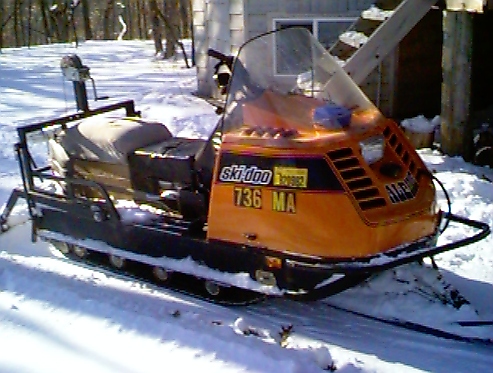

| Here you see one of my Ski-Doo Alpines that's been modified
with a snow grooming wing arm in the back. These classic workhorse snowmobile models have two wide, long
tracks, side-by-side, for great pulling capability through even deep snow, making them ideal for
grooming cross-country ski trails. Most snowmobiles have only a single, narrow, short track, rendering them well-suited to
going at high speeds on packed, groomed trails, but virtually useless in deep snow, where they founder helplessly.
For a better look at the grooming wing arm, click on Wing Groomer Arm. I've got another similar machine, also fitted with an integral, mounted grooming device, and this one
can be seen by clicking on A small 12 volt air compressor ($10) supplies pressure for the shock absorber up front, and for another on the grooming wing, which allows control of downward pressure of the grooming bar on the snow. By varying the pressure to the shock absorber,
the ski is held down hard enough to make the ski bite into the snow,
turning the snowmobile and groomer/sled. It's also helped immensely for
operating in reverse gear, since the tail of the ski would otherwise get
hung-up on almost anything, from deep snow to the lip of the floor slab
getting into the shop. air shockThis picture shows the air-shock. It works very well, and saves me from trying to tug and pull on a stuck sno-mo that couldn't make the turns before this modification. Also visible in this picture is a wheel kit that allows for summertime use of the Alpine. When the kids were heavily into playing paintball, we converted this Alpine into an all- terrain armored personnel carrier, by enclosing it with cardboard boxes from washing machines. A tall perch was provided for the gunner, who sat in the rear, firing through his choice of sliding windows. It was lotsa fun. When replacing the hydraulic shock absorber on the front ski of the Alpine, I used an air shock sized for a Volkswagen Super-Beetle from the mid-seventies. This size shock is correct for both bushing ends (7/16" holes), distance between centers, and for the range of travel required. The guys I talked to in Southern California about their suspension systems for their low-rider cars like the Monroe brand of shock absorbers, but I found Gabriel Hijackers available locally, from the Bumper-to-Bumper automotive store nearby. The manufacturer's stock number is #39507, and they've even taken to keeping a pair in stock locally, though I formerly had to pay more when ordering them specially. The shock absorber needs to have at least 25 lbs. of air (psi) when operating (to protect it's inner workings), and can handle up to 200 psi, though I rarely exceed 100 psi on the snowmobile, often running in the 40-80 psi range. To supply the compressed air, I use an inexpensive 12 volt automotive air compressor sitting on the dash, behind the windshield. These are made to plug into a cigarette lighter, so I wire in one of these receptacles, with a toggle switch on the Alpine's instrument panel for easy on-off while driving. Depending on how tight the system is, you'll need to operate the compressor intermittantly, to maintain the desired pressure to the shock absorber. I use standard 1/4" pipe fittings to allow the inclusion of a valve and pressure gauge, and to connect to the air hose running through the engine compartment to the shock absorber. At the top end, an automotive tire's brass tire stem can be rethreaded to fit the pipe fittings, allowing the air compressor's outlet hose to clamp on to it while driving the snowmobile. There's a little bit of air leakage from this connection, but it's not a lot. There's also a bit of air leakage at the connection on the air shock itself, since it's designed for special air lines to be connected to it's 7/16" fine thread inlet fitting. For use in a car, this connection area is protected from making contact with anything, since it's up underneath the car body, but on the Alpine, it's right out front, often in contact with the snow itself, so I've beefed up the hardware on this end of things, to withstand the stress of this deep-snow contact, also adding a shroud of old inner-tube rubber around the shock's joint (clamping it with radiator hose clamps on each end), to prevent snow from being constantly driven up into it's insides. As I've said, the 7/16" fine thread inlet fitting on the air shock needs to be converted to pipe thread, so that the quick-connect air hose fitting can be installed on the shock. (This allows the air hose to be easily disconnected from the shock absorber when removing the Alpine's hood for servicing the engine.) To accomplish this threading interface, I brazed on a 90 degree pipe fitting to a 7/16" fine thread nut, sealing the fine threads on the air shock with lots of teflon tape, since they're now sealing the connection, and holding the air pressure within the system. The teflon-taped threads and the quick-connect coupling on the shock absorber can also be the source of minor air leaks, but not alot gets out here. This may sound like a lot of monkey-business, but it's pretty simple stuff. The toughest part might be in finding somebody to braze the pipe fitting to the 7/16" fine-thread nut, since most folks don't do their own welding. I'm sure there are other ways to make this kind of adjustment/connection/conversion between threads, too, like maybe just clamping on a rubber air hose.
|